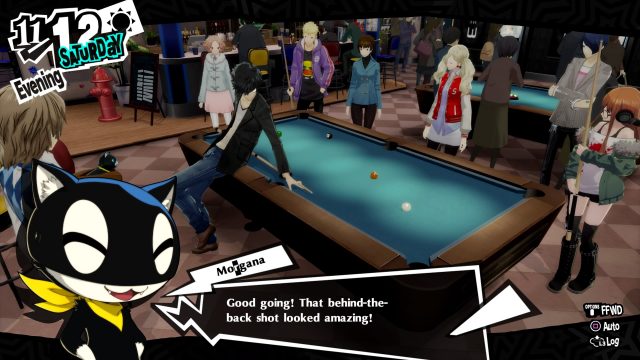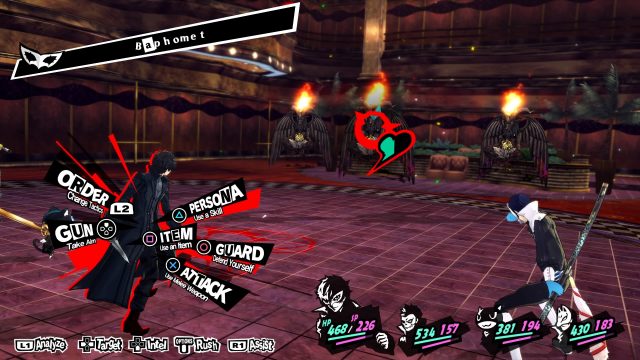Persona 5 Royal Review
A River in a Dry Land
Given its two predecessors received enhanced versions, there was always a presumption that Persona 5, RPGamer’s 2017 Game of the Year, would receive the same treatment. The expectation came true with Persona 5 Royal, though unlike its predecessors the new version arrived just three years later without hitting a new platform. Enhancing an already fantastic and well-loved title, Persona 5 Royal offers undoubtedly the definitive version of the game; its new content adding a good amount of freshness, while tweaks elsewhere ensure it keeps even more in step with players. The sheer size and lack of a massive game-changer might make it a challenge to persuade some to relive the experience, but for any potential new recruits it’s the perfect way to join the Phantom Thieves, as well as for past players to jump back in.
Rather than creating a fictional Japanese town like its predecessors, Persona 5 takes place in Tokyo making use of many familiar districts, particularly Shibuya. After an in media res intro, players control a young man sent to Tokyo at the start of April as part of a probation package after he is after he is unjustly convicted of assault in his unnamed home town. Enrolled at Shujin Academy, he quickly uncovers further injustice being perpetuated by PE teacher Suguru Kamoshida.
When heading to school, he and fellow student Ryuji, previously victimised by Kamoshida, uncover and enter another world known as the Metaverse, which appears as Kamoshida’s own personal castle, where they unlock the ability to summon beings called Personas capable of fighting back against the hostile Shadows that populate the area. Teaming up with a talking feline called Morgana leads them to the startling discovery that the real-world personalities of the Palaces’ rulers can be changed by stealing their treasures within, making them admit their real world crimes, and the Phantom Thieves of Hearts are quickly formed to dispense justice on those otherwise unchecked.
Persona 5 Royal adds two new major characters — student gymnast Kasumi Yoshizawa and school counselor Takuto Maruki — whose stories are built up to across the year; Yoshizawa debuts right at the start, while Maruki comes into the picture after the fallout involving Kamoshida. Otherwise the primary story remains unchanged up until the newly added arc at the end, but there’s certainly no problem with that. Persona 5’s tale involves the expected psychological and philosophical elements, but its larger focus on corruption and people manipulating others for their own benefits takes on even more poignancy now. Those who played through the original game may not find it enough to justify spending all those hours treading familiar territory to get there, but Royal’s new story section does an excellent job of following on from the original climax. It brings things back into a wider examination on the actions of the Phantom Thieves and potential extensions, and ends up resonating much better on a personal level than the original game’s finale.
Persona 5’s focus on the personal is what makes its narrative so engaging. The main cast members are all excellent for different reasons as they grow, learn to deal with their issues, and make best use of their individual strengths. Players also form relationships with many other citizens around Tokyo known as Confidants, initially contacting them to help learn skills that will assist in their work as Phantom Thieves, but quickly developing that initial interaction into a friendship as they become involved in the individual stories that are always immensely satisfying to conclude. The series has always been about forming bonds, and Persona 5’s are as tight as they get. It’s also worth noting that Atlus’ localisation is once again excellent, with the new content combined with additional refinement to the original.

New ways players can spend their time include showing off in billiards and darts, which upgrade a couple of elements of battle prowess.
Much of players’ time is spent on the regular life of a high school student, attending school, meeting friends, and so forth. Royal adds some new options but also adjusts the daily life portion of the game, making it easier for players to raise their attributes high enough to meet certain requirements without having to strictly follow a plan. It also gives players much more time at the start of the game, allowing use of their café lodgings when early bedtimes were previously imposed. This time management has become one of Persona’s most identifiable elements and is great at letting players feel like their own character rather than being driven into following the story. While there can be some choice paralysis caused by the sheer number of options available, with Royal’s tweaks the pressure of those choices is eased.
In addition to all of the original Confidant events — which remain as they were in the original, but with follow-up phone calls adding a little bonus — Persona 5 Royal adds two more sets for Yoshizawa and Maruki. Goro Akechi is also changed into a regular Confidant rather than being levelled up along with the story. The new Confidants have a mid-November deadline to be ranked up as highly as possible, and this is necessary to witness Royal’s new story. The games gives hints to this deadline and provides ample opportunity to achieve it, and they are absolutely worth it even if they don’t pay-off fully until January.
Players will need to invest time to go about their actual Phantom Thief duties, running through individual Palaces or challenging Mementos, a sprawling dungeon representing the collective psyche of the populace with randomised floors. There is always a time limit on completing Palaces, which requires finding a route to the treasure before sending a calling card to the target to make said treasure manifest. Mementos acts as a way to do sidequests for members of public that request help in getting others to see the errors of their ways, as well as earn valuable experience and money between Palaces, with further depths unlocked as the story progresses.
Palaces are generally of the same layouts as in the original release, themed on how each ruler sees themselves and their surroundings, including the dungeon-filled castle, a museum, and a bank, all prime heist locales. The main differences Royal offers are points that utilise the new grappling hook, sometimes bypassing previous enemy-filled zones, as well as new hidden rooms containing Will Seeds. Each Palace has three Will Seeds, which can be turned into a powerful accessory if all are found. Each Palace uses its theme creatively, but those later in the game, while still highly enjoyable, suffer a bit of overexposure compared to the more streamlined ones earlier in the game.
Persona 5’s turn-based combat was already the sharpest in the series, and Royal polishes it further. Lots of little touches, such as immediately highlighting skills enemies are weak to, means that it retains the flow and style of the rest of the game. As players progress in Confidants, they unlock further options or boosts for battle, such as being able to swap characters on the fly, or having party members protect the protagonist from fatal strikes. The steady addition of these new bonuses helps give players a heightened sense of getting stronger. Combat starts out being primarily about identifying and exploiting elemental weaknesses, but these are compounded with things like buffs, status effects, combos, and joint attacks. It’s a perfect example of a simple to learn combat system with umpteen potential tactics to master.
Like the series’ previous two protagonists, Persona 5’s hero is different to his allies in that he is able to access multiple Personas and switch as needed. Each Persona grants its wielder a set of skills, strengths, and weaknesses. New Personas can be obtained by negotiating with Shadows, which can be done if players manage to knock down all their enemies through critical hits or attacking weaknesses, and consists of a mini-conversation where they must select the appropriate responses, or by fusing them in the mysterious Velvet Room. The fusion process is another area of fantastic depth, as players can transfer skills the fused Persona otherwise wouldn’t have, potentially mitigating weaknesses or adding offensive capabilities.
Royal gives players access to five difficulty levels from the start, and can freely switch between the middle three, though the normal difficulty strikes a good, strong balance of challenge and pace. Game overs occur whenever the protagonist is knocked out, but there is usually an option to retry the battle, or go back to a previous point not far away. Royal adds a new twist to Mementos in the form of the character Jose. While having no story role, he gives players something else to keep an eye out for, acting primarily as an in-dungeon store and providing items in exchange for flowers that are picked up throughout Mementos. Stamps collected from machines found at stations on each floor can be redeemed with Jose to add permanent boosts in Mementos to experience, money, and item drop rates.
Persona 5 Royal’s main challenge is fatigue. The game is very long, and most players should expect to spend at least 100 hours reaching completion, with the admittedly leisurely review playthrough running over 150. There’s certainly more than enough thoroughly enjoyable content to last all of that time, but the second half drags on with the increased length of later Palaces and powerful enemies that take time to battle. Day to day life can also become a little dull, as Confidants are completed and fewer interesting activities are left to enjoy. The new Palace introduced in January is thankfully much better than those that precede it, though it would’ve been nice to have a few extra things to do in the evenings for that month.
The game is a visual treat. The UI and its animations are blended in superbly with virtually every aspect of the game, from transitions between areas or in and out of battle, and its striking use of colour and style is always delightful to behold. Royal adds to that style with some new animations for the Showtime attacks involving selected pairs of party members. Meanwhile, the bustle of the real-world locations strikes a great balance between being appropriately busy and letting players easily identify important landmarks or people. The attention to detail is fantastic, and not just in the visuals; touches like optional crossword puzzles and other side activities imparting extra bits of worthwhile knowledge or lore are appreciated.
The audio is also stellar, with Shoji Meguro’s infusion of jazz into the musical score working hand in hand with the game’s visuals. The additional tracks in Royal build upon that, particularly the new battle theme “Take Over,” which plays whenever players ambush enemies. It blends in perfectly with the various Palace themes and holds up superbly despite the many times it will be heard during regular battles. Atlus has not rested on its laurels with the localisation, which now in addition to the excellent English dub, offers Japanese audio, with new French, German, Italian, and Spanish subtitle options.
Persona 5 is certainly not a light endeavour, and Royal’s new additions understandably won’t be enough for everybody to want to go through it again, but for those considering reuniting with the Phantom Thieves, or completely new to the title, Persona 5 Royal is a perfect opportunity and an incredibly rewarding usage of time. Persona 5 already made an incredible mark when it released, and Persona 5 Royal just adds to Atlus’ richly deserved reputation among RPGamers.
Disclosure: This review is based on a free copy of the game provided by the publisher.


All the great things one has come to expect from the series
Additions add more style and tighten up some elements
New story content develops nicely from the original climax into a more personal conclusion
Second half drags on a bit
Additions may not be substantial enough for some to justify full replay










Recent Comments